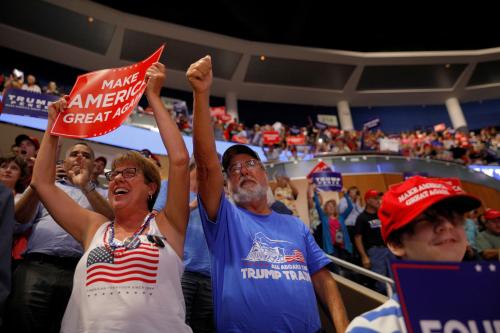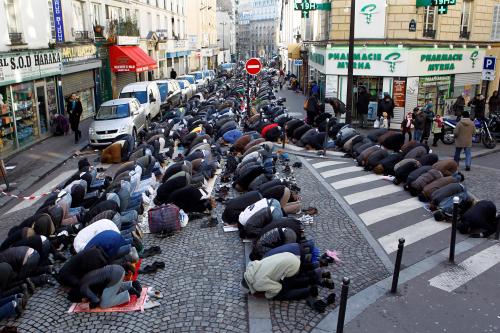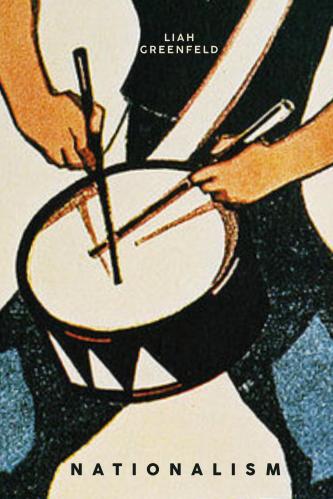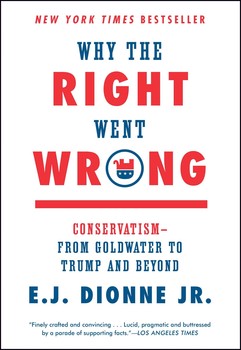This reaction essay is part of the Brookings project—”The One Percent Problem: Muslims in the West and the Rise of the New Populists.” We asked each author to reflect on how reading the other working papers helped them think differently about their own country of focus.
When political commentators discuss the rise of “populism” in Western democracies, United States President Donald Trump’s 2016 election victory is often the first example named — typically followed by the “Brexit” vote in the United Kingdom, the right-wing governments in Hungary and Poland, and growing right-wing strength in many other countries. As the world’s largest economy, as well as a world leader in culture and politics, it is understandable that the U.S. receives disproportionate attention. The power of this variety of right-wing politics in the U.S. should not be overstated, however. Based on my reading of the other papers in this project and my conversations with their authors, I increasingly suspect that the prospects for populism (if that is the correct term for what we are examining) are stronger in Europe than in the United States.
Although Donald Trump managed to win the Republican nomination and subsequently the U.S. presidency on a nativist and anti-Muslim platform, the substance of his presidency has not been as disruptive as many people expected. We should not downplay the importance of President Trump’s rhetoric, but if we focus exclusively on policy, the U.S. has changed little over the last two years. The promised “Muslim ban” faced major legal challenges, resulting in a much more limited policy. That policy’s long-term impact on the nation’s demography will likely be minimal and the next Democratic president will almost certainly reverse it. The Trump Administration has made little progress on its promised border wall, nor has the U.S. experienced a significant decline in immigration.
It is true that President Trump has slashed the number of refugees admitted to the United States, which disproportionately affects Muslims, but refugees have always represented a very small percentage of immigrants to the U.S. — only about three million refugees have been resettled in the U.S. since 1980. Undocumented immigrants were furthermore deported at higher rates under President Obama than under President Trump. This is not necessarily because of the Trump Administration’s lack of desire to deport undocumented immigrants. Rather, under President Trump, states and municipalities under Democratic control have been less eager to cooperate with federal agencies. The executive branch’s bureaucratic incompetence may also play a role.
The Trump Administration will not be in power forever. Even if President Trump wins a second term as president, second terms are historically less productive than first terms. It is additionally unlikely the Trump will ever again enjoy Republican majorities in both chambers of congress. As more time passes, I find it decreasingly likely that Trump will fundamentally transform the United States in terms of immigration, foreign policy, or the nation’s relationship with Islam and Muslims.
As more time passes, I find it decreasingly likely that Trump will fundamentally transform the United States in terms of immigration, foreign policy, or the nation’s relationship with Islam and Muslims.
In other papers in this project, we learned about increasingly powerful political parties dedicated to immigration restrictions, of well-known political entrepreneurs focused entirely on restricting Islam’s influence in European societies, and of right-wing populist governments consolidating their power. Although further right-wing populist victories in Europe are not inevitable, in recent years these movements have effectively shifted the political conversation in their own direction. Many mainstream parties have begun to embrace talking points once relegated to the far-right.
This is less the case in the U.S. Trump’s victory has not fundamentally changed the Republican Party or led to substantively significant immigration policy changes. Trump’s electoral base furthermore does not seem particularly concerned about Muslim immigration as such — which is not to say it is especially tolerant.
We can reasonably criticize President Trump for promoting anti-Muslim prejudice, and he may have played a role in promoting these attitudes. A recent poll published by the Institute for Social Policy and Understanding showed a small but statistically significant increase in its Islamophobia index over the last year. A poll conducted by the think tank New America additionally found that Republicans are especially likely to view Muslims with suspicion. On the other hand, we should remember that, on average, Republicans have long been likely to express negative views of Muslims and Islam. We should therefore investigate whether we saw a spike in these attitudes after Donald Trump entered the political arena. In my own analysis of the American National Election Survey data, I found little evidence that this occurred. In the 2012 survey, the mean feeling thermometer score for Muslims among all Republican identifiers was about 38. In the 2016 survey, conducted after then-candidate Trump called for a total ban on Muslim immigration, the mean score among all Republican identifiers was a bit higher — about 45. This is not a definitive finding, of course, but it does indicate that President Trump has not ushered in an unprecedented era of anti-Muslim animus, even among Republicans.
In my own interviews, I came across no subjects seriously concerned about the “Islamification” of the United States. Such sentiments exist in this country, and there is a large audience for Islamophobic rhetoric. However, this particular fear is apparently less politically significant in the U.S. than in Europe. This is likely because Muslims remain a very small percentage of the U.S. population, and are only a small part of the ongoing and dramatic demographic change occurring here. In much of Europe, Muslim immigration is a key source of demographic shifts, and thus of great concern to European nativists. In the U.S., Muslims are just one small part of the broader phenomenon.
Even if anti-Muslim sentiments are just as strong in the U.S. as elsewhere, there are compelling historical reasons to doubt the long-term sustainability of any right-wing populist movement in the United States. Political expressions of these kinds of right-wing sentiments have rarely led to successful long-term organizations. These movements typically form around the personality of a charismatic politician, and then recede from political significance after that politician is defeated or otherwise fades from the scene. Although they had different agendas and styles, this was the case with George Wallace, David Duke, Ross Perot, and Patrick Buchanan.
Donald Trump is presumably different because, unlike other right-wing populists, he won his election. However, since his victory, we have seen no significant organizations form to promote a populist agenda that is fundamentally distinct from the older and well-established conservatism promoted by more conventional Republicans. It is notable that, during the first two years of the Trump Administration, the president largely allowed Rep. Paul Ryan and Sen. Mitch McConnell to set the domestic policy agenda, and they focused on traditional Republican policies like tax cuts.
It is additionally significant that Trump’s election has not led to a significant growth in right-wing populist candidates — though it is notable that most elected Republicans have chosen not to object to President Trump’s anti-Muslim rhetoric. There has not been a surge of “Trumpists” taking down “establishment” Republicans in GOP primaries. This was going to be Steve Bannon’s major project after leaving the White House, but it fell apart when the candidate he supported in Alabama — Judge Roy Moore — won the Republican primary but lost the general election to a Democrat — costing the GOP a safe Senate seat. Bannon has apparently now given up on changing the Republican Party through primary elections. It is telling that his efforts are now primarily focused on Europe, where his movement has brighter prospects for further victories.
Another curious element to Donald Trump’s election is that there was such little groundwork laid for a right-wing populist government in the United States. Viktor Orbán has been a mainstay of Hungarian politics for decades. The Le Pen family has been promoting nativism in France for generations. The Austrian Freedom Party has a similar long history. Although the United States has always had certain far-right populist elements, that political tendency had mostly existed on the fringes of political life, or it was harnessed and redirected toward pro-capitalist, mainstream conservative ends.
Before Donald Trump arrived, most observers assumed that the 2016 GOP presidential candidate would be an ordinary Republican, or possibly the libertarian-leaning Rand Paul. When Trump unexpectedly won the Republican primaries and then the presidential election, there was not a preexisting political infrastructure to promote his nativist and populist agenda. This variety of right-wing populism had been almost entirely dormant in American politics since Patrick Buchanan’s failed insurgent presidential campaigns in the 1990s, which probably explains why most significant figures in the Trump White House have been relatively conventional Republicans. Over the last few years, we have witnessed an effort to reverse engineer an intellectual foundation for “Trumpism.” Yoram Hazony, author of The Virtue of Nationalism and chairman of the new Edmund Burke Foundation, has led one of the more significant efforts in this direction. This year, Hazony’s organization sponsored a conference on “National Conservatism,” which included speakers discussing many themes typically associated with right-wing populism — immigration restrictionism, protectionism, and the acceptance of a more robust welfare state. The event also included Daniel Pipes, known for his anti-Muslim views. The success of Tucker Carlson’s program on Fox News — which is often infused with right-wing populist themes — indicates there is a large audience for these ideas. It nonetheless remains to be seen whether this intellectual current can become a dominant force in the Republican Party.
Despite winning the White House, right-wing populism in the United States remains a disorganized force. It has not created a disciplined movement akin to the once-formidable Christian Right, nor has it raised the kind of money associated with pro-capitalist, anti-tax organizations like Americans for Prosperity. Whatever populist energies propelled the Tea Party movement (now mostly defunct), they were quickly captured and redirected into more conventional conservative policy proposals. Organized groups are key forces in democratic politics, and American right-wing populists are bad at forming them.
On the other side of the spectrum, Donald Trump’s presidency has both energized the American left and led to changing attitudes among Democrats. Specifically, Democrats have moved sharply to the left on questions of race and immigration, and they express increasingly positive feelings toward Muslims. When Democrats eventually retake the White House, it is quite likely that any anti-immigrant or anti-Muslim policies implemented by the Trump Administration will be quickly undone. This seems to be a critical difference between the United States and Europe: Trump’s victory energized American progressives and encouraged many to embrace an agenda of multiculturalism and tolerance. For example, all major candidates for the Democratic presidential nomination are running on explicitly — and even ostentatiously — anti-racist, pro-immigrant platforms. In many European countries, in contrast, it appears that mainstream politicians and parties have responded to the far-right’s growth by seeking to co-opt and accommodate the right’s agenda. The reports on Denmark, Austria, and the Netherlands demonstrate this clearly.
Looking across these many case studies, we saw that some of the same political trends were occurring in many different contexts. Yet we also saw important differences. As we consider what we can learn from this study, as well as the other research being conducted along these lines, I hope to see more consideration of what accounts for the variation across national boundaries.
The economic status of Muslims in different contexts is likely an important explanation for differences across countries. In many of the European cases examined in this project, Muslim immigration was treated in part as an economic problem, with Muslims being viewed as an economic underclass and thus a drain on welfare and other government services. Although welfare chauvinism certainly exists in the United States, and restrictionists often deploy it in arguments against immigration, Americans do not seem to equate Islam per se with poverty. This may be partly due to objective differences between the economic standing of Muslims in the U.S. and Muslims in Europe. Recent Muslim immigrants to the U.S. and their children of tend to be wealthier, on average, than the rest of the population
Some differences between the U.S. and Europe are simply institutional — the impossibility of viable third parties closed off a critical option for the far-right in the U.S., for example. It will be especially useful, however, if we can discern which differences can be explained by important decisions made by political actors. Some of what we have examined in this project resulted from political and economic changes that social scientists can study and measure and use to make predictions. But there is also an unpredictable human element, often driven by individual (and idiosyncratic) political entrepreneurs. What would politics in the Netherlands look like today if Geert Wilders had never entered the arena? What if Trump had remained just a reality TV star? I look forward to reading more studies that combine quantitative and qualitative approaches, so we can better disentangle the predictable from the stochastic.
Our task is additionally challenging because there is not an apparent linear relationship between the size of a nation’s Muslim population and the political reaction to that population. That is, some of the most successful nativist parties are found in countries, such as Hungary and Poland, with a very small percentage of Muslims. On its face, this suggests that contact with Muslims can lead to higher levels of tolerance. On the other hand, those European countries with larger Muslim populations, such as France, have also seen growth of the far-right. As Gordon Allport noted when he articulated the intergroup contact theory, intergroup contact can reduce prejudice, but this will only be effective under certain conditions. At present, there does not appear to be an obvious, scalable toolkit that can ensure greater tolerance and understanding across cultural boundaries.
As work on these subjects continues, I also want to encourage researchers to be precise and disciplined in their use of words — this is something I must work on, as well. The term “populism” often seems like a catchall term for this moment’s disruptive politics. I am not sure that this is always appropriate. What we often call populism at times seems indistinguishable from the far-right. Populism is not inherently intolerant, nor is nativism inherently populist — much of the far-right is simultaneously elitist and nativist.







Commentary
Are Trump supporters anti-Muslim?
A 'Muslims in the West' reaction essay
December 4, 2019